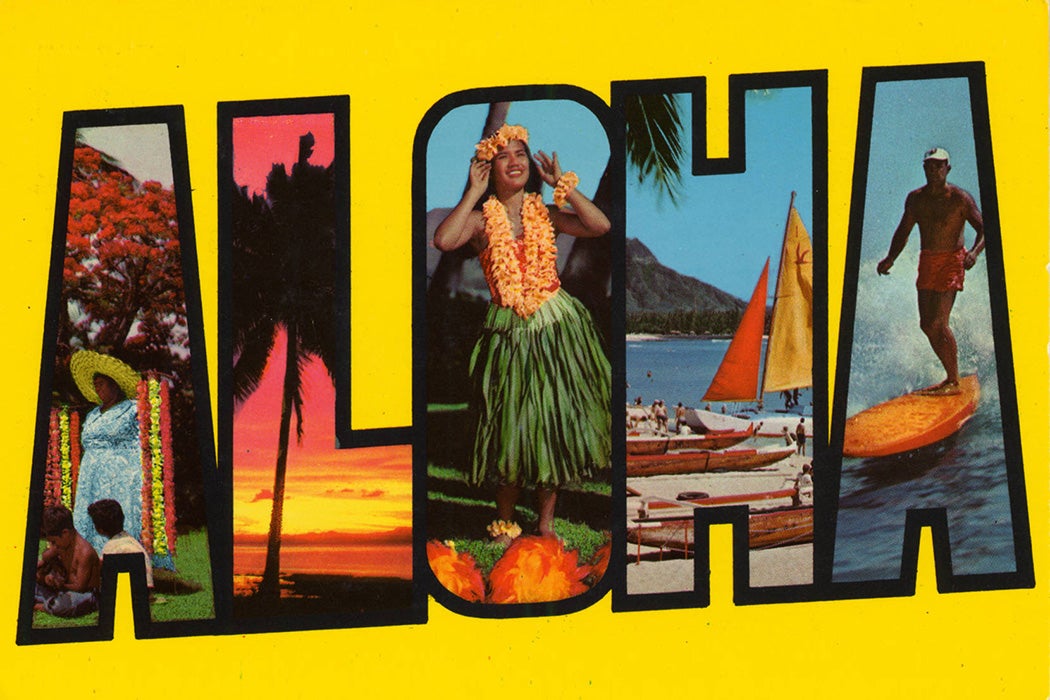Jet travel to Hawai‘i arrived in 1959, the same year as statehood. Tourism was intimately connected with the birth and growth of the new state as the industry and both local and federal governments worked together to sell what we now call “multiculturalism.”
“Aloha Spirit” marketing, writes historian Sarah Miller-Davenport, “helped turn racial tolerance into a salable, if abstract, commodity” for the benefit of both business and foreign policy, especially in the American effort to win allegiances in Asia during the Cold War. “As Hawai‘i sought to distinguish itself from other vacationlands,” she notes, “it spun a dual narrative of racial difference and racial mixing to help sell the islands as a unique destination where Americans could purchase a transformative leisure experience.”
This double narrative was “part of a larger discourse around Hawai‘i’s special role as a multi-ethnic offshore state of the US,” Miller-Davenport writes, “but it also took on a life and logic of its own as race was deployed in the service of large-scale financial gain.”
The Aloha Spirit was an “elusive vision of social harmony, a ‘gentle spirt of fellowship and goodwill’” of ethnic festivals, exotic food, and “Golden People.” According to Miller-Davenport, this imagining of Hawai‘i, elusive as it may have been, led to the state’s multi-ethnic society becoming “not only a site of consumption, but an object of consumption itself.”
Things began in-flight. Stewardesses “representing the many ethnic heritages of Hawaii” (in a description offered by Hawaiian Airlines) served up “gourmet adventure” on a plate along with Mai Tai cocktails. Once on the islands, leis, luaus, hula girls, surfing, tiki, and a “montage of minorities” helped make tourism the driving force of economic growth in the new state. Tourism quickly outpaced sugar and pineapple production, among island industries, and even surpassed US military expenditures as part of the local GDP in 1968. By 1970, the islands had twice as many annual visitors as residents. By the end of the century, annual visitors outnumbered residents nearly six to one.
Compared to a mainland rocked by the Civil Rights struggle against segregation, Hawai‘i was described as early as 1949 as a “multiracial democracy.” In 1966, the locally well-known Hawaiian-Chinese minister Abraham Akaka wrote that “God designed these islands for immigrants” in the pages of the United Airlines in-flight magazine.
James Michener’s thousand page novel Hawaii, which reached number three on the US bestselling list the same year as statehood, introduced the idea of the “Golden Man” of Hawai‘i. Michener said this wasn’t a racial category, but when the Hawai‘i tourist board launched its Golden People campaign in 1969, it added a bit more specificity: racial harmony and racial mixing went together. Notably, the islands’ white population wasn’t included in Golden People advertising; it was Hawai‘i’s colorful ethnics who were positioned as spectacles for a white audience. Writes Miller-Davenport,
The language of multiculturalism obscured the racial and class privileges that enabled so many American tourists to travel to Hawai‘i, where non-white service workers would help affirm their racial liberalism.
Partly because of Hawai‘i’s majority Asian population, the US government was able to position the newest state as “a symbol of American egalitarianism” and “a gateway for Americans into the realm of the foreign.” The notion of a “bridge” or “gateway” to Asia became a large part of the islands’ boosterism.
Weekly Newsletter
Multiculturalism has generally been thought of as a response to “racial and ethnic minorities asserting their right to cultural recognition,” writes Miller-Davenport. This defines multiculturalism as grassroots protest, originating in demands for educational reforms. Miller-Davenport instead finds the origins of multicultural in elite business/state manifestations such as the selling of Hawai‘i on the global marketplace in an era of decolonization.
“Liberal policy-makers and business leaders” saw the “celebration of social differences as a means both to facilitate American expansionism abroad and to make money at home,” she writes.
This may be why multiculturalism has been so easily coopted—the colorization, as it were, of capitalism—at the expense of real structural change.
Support JSTOR Daily! Join our membership program on Patreon today.







